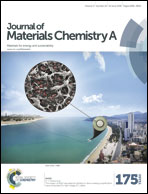Film-through large perovskite grains formation via a combination of sequential thermal and solvent treatment†
Abstract
Organic–inorganic halide perovskites have recently attracted strong research interest for fabrication of high-performance, low-cost photovoltaic devices. Recently, we reported a highly reproducible procedure to fabricate high-performance organic–inorganic halide perovskite solar cells. This procedure, based on a one-step, solvent-induced, fast deposition-crystallization method, involves the use of sec-butyl alcohol as a new solvent to induce the CH3NH3PbI3 fast crystallization deposition. In the present study, we propose a reproducible fabrication method to prepare both flat and large-grain perovskite film by adding a pre-annealing step to strengthen the perovskite nucleation, aiming to facilitate the excess CH3NH3I and solvent removal in the sec-butyl alcohol soaking process, in which all films with thickness between 420 nm and 1 μm performed uniformly. The best performing planar device obtained with this procedure had an efficiency of 17.2% under AM 1.5G illumination and an average power conversion efficiency of 16.2 ± 0.5%. We also analyzed the efficiency of halide perovskite planar solar cells as a function of the perovskite film thickness; the efficiency dropped only slightly to 15.7% when the perovskite film thickness was increased to 1 μm.

- This article is part of the themed collection: 2016 Journal of Materials Chemistry A Most Accessed Manuscripts

 Please wait while we load your content...
Please wait while we load your content...